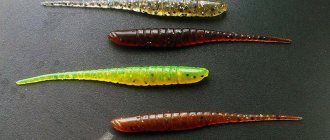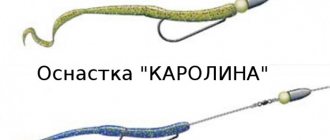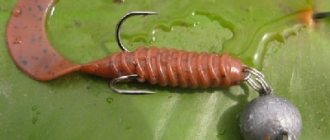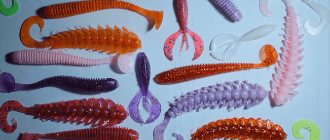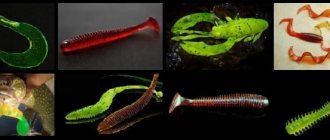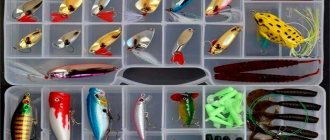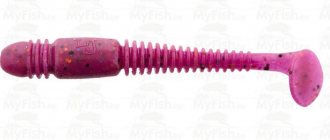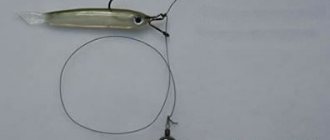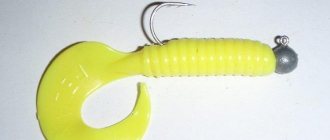Silicone baits are artificial baits for catching fish, which are considered much more convenient and cheaper than live bait. The first such silicone products appeared on the market for fishermen back in the middle of the last century. They come in different types and sizes, but all of them are equipped with hooks. Proper rigging of silicone baits is a very important topic for effective and successful fishing. We will look at how to properly put silicone bait on a hook of one type or another in our article. For clarity, all installation methods are supplemented with photos and videos with step-by-step actions.
Equipping silicone baits with a jig head
To properly attach a silicone bait to a jig head, you need to perform a few simple steps (see photo below):
- We apply the hook with a jig head to the bait to determine the puncture site in the back, where the sting will be brought out.
- We make a puncture from the head of the silicone fish and begin to put it on the hook.
- We bring the hook tip out, straighten the bait on the hook.
Features of installing twisters on a double
Twisters differ in their type from vibrotails by a longer working body in the form of a tail with a spiral texture and by the body itself, a cylindrical and symmetrical shape. When choosing a hook suitable for the nozzle, you need to pay attention to the length of the fore-end, which is strictly kept at half the length of the cylindrical dense part of the twister. The point of the hooks is placed on the back of the twister, which is determined by the even, kinky hanging of the tail of the bait taken in the fingers, located in a horizontal position. The baits are placed tightly on the double, with the tip pressed to the body of the twister. The fastening ring, released in the front center of the end, should not protrude more than 1–2 mm beyond the dimensions of the nozzle. Otherwise, the bait will constantly move along the fore-end when moving, breaking the punctured hole and becoming unusable.
Installation of silicone baits on an offset hook
The most suitable type of bait for offset is considered to be a vibrating tail, the example of which is used to discuss installation. Equipment for an offset hook is made according to the following algorithm:
- First, you need to insert the hook tip into the front part of the bait, which comes out through its middle after 5-6 mm.
- Next, you need to unfold the bait and stretch it along the entire length of the fore-end until the head part rests on the eye of the offset.
- After this, a puncture is made in the belly of the bait, and the sting is removed from the back of the bait.
- After such manipulations, you can also hook the sting to the back to reduce snags during the liner.
One of the disadvantages of such equipment is the possible escape of the fish if it does not have enough strength to bite through the silicone. Pros: the ability to fish in areas of the reservoir that are snagged and overgrown with algae.
How to put a silicone bait on a double hook
Doubles are most often used for installing large-sized silicones. With double hooks, the probability of successfully hooking a fish increases almost 2 times.
Before mounting, you should compare the size of the bait and the length of the hook. For greater convenience, it is better to first unclench the double.
- We apply the double to the bait to determine the puncture location.
- Using the tip of the hook, we pierce the bait from one side.
- We pull the needle of the hook from the other side of the vibrotail, and draw the fore-end through the body of the bait. In this case, the eye of the forend should be in the center of the bait.
- Next, we draw the forend along the entire length of the bait so that the eye now comes out in the bow of the vibrotail, and the forend forms its internal frame. The twin's fastening ring should come out of the head of the silicone.
About
How to put a vibrating tail on a double
Comparing the hook and the bait, it initially seems quite difficult to carry out the operation of equipping a vibrotail with a double, but in essence these are elementary manipulations that are accessible to every angler.
Installation is carried out using two main methods, one of which requires additional equipment in the form of a thin and durable 2–3 mm rod. The method using a rod involves the initial puncture of a hole in the body of the silicone and the subsequent insertion of the forend of the hook into this through puncture. The main point here is the selection of a rod with a diameter that is an order of magnitude smaller than the thickness of the accessory forend. Otherwise, the nozzle will dangle randomly on the hook without being firmly fixed.
You can put a vibrating tail on a double using the second method without additional equipment by piercing the body of the fish across the back with a through hole with one of the parts of the hook and spreading the double apart, pushing the fastening ring into the mouth area of the bait. Using the example of different types of nozzles, we will consider the main features of installation.
Equipping silicone baits with a tee
Installation on a treble hook seems to be more complex compared to an offset or double hook. The simplest way is to pass a piece of thin wire through the body of the bait so that it comes out at the tail, and a swivel with a treble hook is attached to it.
A more complex installation method is carried out in the following way:
- Using a short tube with a diameter of no more than 5 mm and a length of 2 cm, a hole is made in the side of the bait.
- A tee is applied to the hole location so that its eye protrudes from the head part.
- Then one of the hooks of the tee is pulled into the hole so that it ends up on one side. One of the hooks also remains on the other side, and the third is pierced from the inside of the bait.
- The eye of the tee is attached to the eye of the Cheburashka or to the ring of the jig head.
1 2 3 4 5 6
This process is shown in more detail in the video below:
How to attach a treble hook to a silicone fish
Equipping a classic rig with a triple hook is considered the easiest way to increase its mobility. This method reduces the number of fish landings and increases fishing efficiency, which is especially useful for beginning spinning anglers to know, although its installation is difficult for beginners.
Another way to attach a tee is to connect it to a jig head using a metal leash. In this design, you can even attach two or more tees, placing them on the side, bottom or top of the bait.
Also effective can be considered a method with a collapsible Cheburashka and a corkscrew, which is a fixing element of the equipment screwed into the body through the front part of the bait.
In the video below you can more clearly see the process of equipping baits with additional tees:
Twisters for perch and striped fishing techniques
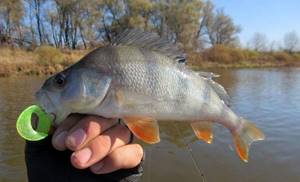
Fishing for perch with a twister can be carried out both in bodies of water with a current and in still water areas. This relatively small predator lives in packs. If on rivers striped sites can be found at the borders of contact between strong currents and relatively calm water, then in standing waters perches love snags on the bottom, junctions of clear water with thickets and all sorts of bottom anomalies, hiding behind which they calmly lie in wait for a passing victim. You can use a twister for perch throughout the entire period of open water, and we will talk about the nuances of selecting a perch bait in the following sections of the article.
Selection of bait by color and smell
Perch prefers baits in contrasting zonal colors.
Important! The practice of perch fishing has noticed that the presence of red color has the ability to improve the bite regardless of the time of year and the intensity of illumination of the reservoir.
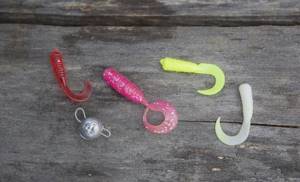
The point of attack in the form of the red head of the silicone or its tail against the background of a white, light green, yellow and brown base brings the most significant fishing results. At depths, lures of a light green-acid color work; compared to other colors, they are much more noticeable in dark water and their color spectrum is not distorted compared to the yellow, red and blue colors, which become much dimmer at depths of more than three meters than in light. Twister fishing in the fall is much more successful with the use of edible rubber with the smell of fish oil and interspersed with glitter, shimmering with rainbow tints.
How to install a twister when fishing for perch
Spaced mounting of the bait is considered pure perch fishing. The retractable leash and the drop-shot method are especially productive. For perch hunting, silicones are selected in sizes of three to five centimeters, which are installed 30 cm from the sinker, and therefore the bottom of the reservoir. The dregs from the load stretching along the bottom arouses the initial interest of the predator, which, upon approach, noticing the silicone, attacks the bait. Under some fishing conditions, it is possible to use several baits simultaneously, installed in different water levels for a more efficient search for fish sites.
Posting bait and its methods when catching perch
The method of guiding the twister depends on the activity of the fish, the strength of the current and the bottom topography. An active perch reacts to sharp and fast movements. Passive fish require slowdowns and pauses during regular movements. Stepped fishing is used to catch fish at depth differences and exits from pits. This technique is also effective when fishing the bottom with a distinct profile of multi-level relief, where smooth plateaus alternate with holes and ledges in the bottom base.
Uniform movements are more effective on a flat bottom, on sandbanks and when fishing in snags. Also, using a uniform retrieve, the boundaries of thicket banks and smooth ascents from the riverbed on sandy river spits are fished.
How to put a silicone worm on a hook
In most cases, when installing a silicone worm, they use a “wacky” rig: they pierce it in the middle with the sting of the hook, or put a small rubber ring on the bait with a slight tension, to which the hook clings (the second option is preferable, since this way the worm does not tear and lasts longer serves). In this case, 2 hanging ends are formed, which attract fish with their movement during wiring. The equipment can be supplemented with a metal peg-weight, which is inserted into one of the edges of the worm. Thus, one end of the silicone worm lies on the bottom under the weight of the peg, and the second begins to play with every pull of the rod. This method of installing a silicone worm can be used for catching perch, pike or even trophy peaceful fish. It is he who can give the long-awaited rich catch, which is beyond the power of other baits.
Photo: How to attach a silicone worm to a hook (4 possible options)
Rigging silicone worms can be done in other ways:
About
Twister wiring
When fishing with twisters, a variety of wiring options are used, but the main methods are uniform and stepped wiring.
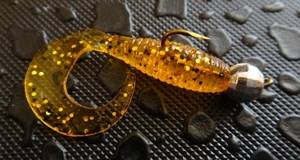
Uniform wiring is relevant in cases where you want to place the bait as close as possible to the “carpet” of aquatic vegetation, along its border. This wiring method also works well in shallows and in places with a flat bottom.
As mentioned above, the optimal speed depends on the degree of activity of the fish. Slowly moving bait is more often attacked by passive predators and pikes waiting in shelters.
Stepped wiring is used if the previous method is unsuccessful; it is also appropriate when fishing in areas with a bottom that is not uniform in relief.
In the summer, it is recommended to carry out the “step” more energetically, letting the bait fall for 3-4 seconds. On cold days, the “step” should be smoother, with a pause of 6-10 seconds.
Rigging large silicone baits
Particularly large baits are used less frequently, in cases where the angler sets out to catch not just a perch or pike, but a real trophy. Such silicones can be used both when casting with a spinning rod and when trolling.
One of the simplest and most effective methods of equipment is the installation of large silicone 15-25 cm long with two tees, which are placed on leads.
This type of equipment is based on a jig head with a fairly powerful hook. All accessories must be selected in accordance with the size of the bait and the depth of the reservoir. It is in this case that you need to choose the largest possible hook size, for example, 10/0 or 12/0. Installation of such equipment is carried out as follows:
- One end of the leader must be attached to the ring of the jig head, for example, using a crimp tube.
- Next, you should measure each leash to the place where the first and second tees will be attached.
- After this, a small loop is created using a crimp tube, to which the first hook is attached. Then the leader is measured and a second eye is created for another tee.
- The jig head is threaded through the tube, and the hooks are stuck into the bait at appropriate distances from each other.
In dense thickets, you can also use treble hooks located on the back of the bait. In this case, the hooks must be placed inside it using wire pins.
Hooks for silicone baits
In addition to the fact that for successful fishing you need to choose the right proportions of the size of the hook and bait, there are other nuances in selecting these accessories for fishing. An important criterion for effective casting is the sharpness of the hook, due to which most hooks occur.
In most cases, an offset hook is used to catch predatory fish. It is also ideal for its role as a no-hook in dense brush and gnarled terrain.
How to choose a hook for silicone bait
A special point when choosing a hook for silicone is the height of the bend. Low hook deflection is not suitable for silicone accessories, as they will not move/flex when bitten, resulting in little or no hooks.
About
Useful tips and tricks
The following tips will help you get a good catch:
- When mounting a rig with silicone bait, you need to try to ensure that the hook passes exactly through its center. This will help keep it balanced when moving and not cling to snags when throwing.
- Experienced fishermen advise storing silicone fish in plastic or silicone bags, preferably with a zip-lock fastener.
- When going fishing, you should take several baits of the same type with you, as the fish can spoil the only one, and the fishing will end there.
- It is better to catch active fish with twisters and vibrotails, while for passive fish, worms or slugs are preferable.
What is a twister?
Among fishing enthusiasts, this name refers to a huge selection of baits made of silicone. They have a cylindrical elongated shape with a flat crescent-shaped tail at the end. In stores you can purchase modifications of twisters that have their own play during wiring. Several years ago, manufacturers of such baits used ordinary silicone material for production. Its use provided the products with high levels of elasticity and plasticity, which is why in the water element the baits sat securely on the hooks and behaved quickly, imitating the behavior of small fish. Predators attacked them, reacting exclusively to movements, but were not always detected.
Today, edible soft rubber has come to the fore in the production of artificial baits. Its creators add amino acids, flavored salts, and various attractants to silicone. Thus, baits appear that not only actively move, but also smell attractive, without raising doubts among predators.
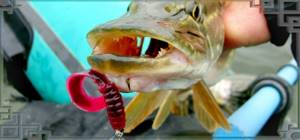
“Edible” also has its own drawback - unreliable strength. It doesn't last long and quickly deteriorates. To bring it out of working condition, even the grip of a perch and asp, which do not have toothy mouths, is enough. On the other hand, such baits are much more catchy, which makes up for their disadvantage, besides, silicone is a consumable material, and nothing can be done about it.
Beginner fishermen confuse twisters with vibrotails. Both baits are made from silicone, but the second shape is more like a small fish. The main difference between a vibrotail and a twister is a more mobile tail. Thanks to this design, it plays better when wired.
To learn more:
Features of catching pike on girders
What to choose, a twister or a vibrotail, each angler decides for himself. For pike hunting, the best option would be the second one; in water it is characterized by vibrations with low frequency and wide amplitude. Toothfish like such bait games more, since twisters create high-frequency vibrations.
They are also given an advantage in cases where long and targeted casts must be made from the shore. Their flight properties are much better than those of vibrotails. But if the fishing spots are covered with vegetation or snags, then it is advisable to choose a twister with a bait that catches less. In any case, every spinner should have new twisters and vibrotails that have been in “battles”.
Video: The best ways to mount silicone baits on a hook
In order for a fisherman to return from fishing with a rich catch, he needs not only skill, dexterity and a good choice of place, but also good gear with different types of bait. In turn, correct installation of silicone baits on different types of hooks will ensure fewer hooks on underwater obstacles and a higher percentage of fish being caught.
Views: 774
Similar articles:
- Offset hook: types, sizes, selection, installation The success of any fishing depends not only on the skills of a skilled fisherman...
- Hooks for pike: types and features, sizes, which hook is better to choose Predatory fish like pike are considered a desirable trophy for most fishermen,…
- Catching pike with silicone. The best silicone lures for pike Silicone lures for pike are baits that are consistently popular...
- Jig-rig: installation, wiring methods, advantages and disadvantages Just 3-4 years ago, when jig-rig was just gaining popularity, many…
How to catch pike with a twister
A pike twister, while not differing in shape, differs significantly from a perch fishing tool in its size. For pike hunting, baits measuring 12–15 cm are purchased, and if you are confident that the reservoirs contain specimens weighing 5–7 kg, even a twenty-centimeter version will become an acceptable option for fishing. The silicone is toothy in nature with a ribbed body and a wide tail.
Important! Edible rubber attracts predators at any time of the year, regardless of the water temperature.
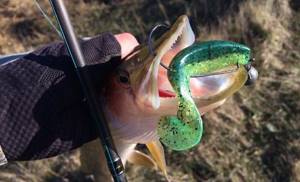
As a rule, pike attack more solidly colored silicone, which is selected based on the preferences of the predator at the time of fishing. It is worth noting that when silicone gets into a pike’s mouth, even if the outcome of the fight with the trophy is unsuccessful for the angler, it is subject to serious deformations. For pike hunting, you need to purchase several identical promising baits so that there are conditions of equal turnover, which sometimes plays a decisive role in the success of the entire fishing.
Features of installing twisters on pike
The peculiarities of installing twisters on pike differ in that anglers prefer mounting silicone baits on stationary jig heads and assembling baits in combination with articulated weights or Cheburashkas. Since pike fishing is mostly carried out in cramped conditions, snags and with the presence of aquatic vegetation near the bottom, it is convenient to use offset hooks in hinged installations, which make the bait non-snagging. When fishing in clear waters, it is justified to use sliding double hooks, which greatly increase the chances of reliably catching a pecked trophy. When using stationary weights, they try to place the hook of the jig head as close as possible to the body of the bait, thereby reducing the likelihood of hooks and picking up all kinds of plant debris that affects the quality of the retrieve and the attractiveness of the installation.
Posting bait for pike
To catch pike with a twister, you need to use a stepwise retrieve, alternating with long pauses, with passive fish reaching up to 10–12 seconds. The bait is necessarily placed on the bottom, receiving a kind of blow, which additionally attracts a predator from distant distances with its sound. The step is carried out in three or four full turns of the reel, thus obtaining a clear horizontal direction of each stroke of its stroke of 20–30 cm. The attack almost always occurs at the moment the bait stops and its free fall to the bottom, when the action of the tail reaches the main operating parameter irritating the predator.
